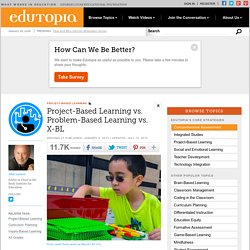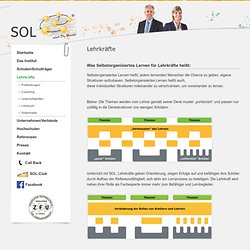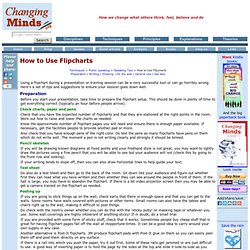

Project-Based Learning vs. Problem-Based Learning vs. X-BL. At the Buck Institute for Education (BIE), we've been keeping a list of the many types of "_____- based learning" we've run across over the years: Case-based learning Challenge-based learning Community-based learning Design-based learning Game-based learning Inquiry-based learning Land-based learning Passion-based learning Place-based learning Problem-based learning Proficiency-based learning Service-based learning Studio-based learning Team-based learning Work-based learning . . . and our new fave . . .

Zombie-based learning (look it up!) Let's Try to Sort This Out The term "project learning" derives from the work of John Dewey and dates back to William Kilpatrick, who first used the term in 1918. Designing and/or creating a tangible product, performance or event Solving a real-world problem (may be simulated or fully authentic) Investigating a topic or issue to develop an answer to an open-ended question.
Understanding the Adult Learners Motivation and Barriers to Learning. Agenda des prochains évènements. Une année de formation-action 2016. Lehrkräfte - SOL Institut - Lehrkräfte geben Orientierung. Was Selbstorganisiertes Lernen für Lehrkräfte heißt: Selbstorganisiertes Lernen heißt, jedem lernenden Menschen die Chance zu geben, eigene Strukturen aufzubauen.

Selbstorganisiertes Lernen heißt auch, diese individuellen Strukturen miteinander zu verschränken, um voneinander zu lernen. Bisher: Die Themen werden vom Lehrer gemäß seiner Denk muster „portioniert“ und passen nur zufällig in die Denkstrukturen von wenigen Schülern. Unterricht mit SOL: Lehrkräfte geben Orientierung, zeigen Erfolge auf und befähigen ihre Schüler durch Aufbau der Reflexionsfähigkeit, sich aktiv am Lernprozess zu beteiligen. Die Lehrkraft wird neben ihrer Rolle als Fachexperte immer mehr zum Befähiger und Lernbegleiter. OcTEL. Mainstreams. Constructivist teaching methods. History[edit] Constructivist teaching strategies[edit] Characteristics of Constructivist Teaching[edit] One of the primary goals of using constructivist teaching is that students learn how to learn by giving them the training to take initiative for their own learning experiences.

According to Audrey Gray[who?] , the characteristics of a constructivist classroom are as follows: the learners are actively involvedthe environment is democraticthe activities are interactive and student-centeredthe teacher facilitates a process of learning in which students are encouraged to be responsible and autonomous Examples of constructivist activities[edit] Furthermore, in the constructivist classroom, students work primarily in groups and learning and knowledge are interactive and dynamic. Experimentation: students individually perform an experiment and then come together as a class to discuss the results.Research projects: students research a topic and can present their findings to the class.Field trips. Constructivism. Influences on constructivist "theories" of instruction Qualitative/naturalistic research paradigms: finding meaning in particulars rather than generalizations Situated cognition/learning: learning in the "natural" setting seems to be quite different from learning in school Schon's ideas about reflective practice in the professions: the real challenge of professional practice is framing a problem, not solving it after it has already been defined.

Cognitive and intellectual development theorists: e.g., Vygotsky, Bruner, Piaget, William Perry, Belenky Semiotics Hypertext/hypermedia Some points to ponder about constructivist approaches 1. Constructivism embodies a particular set of beliefs about the nature of reality and learning, as well as a set of preferred teaching techniques of "moves". 2.
Constructivist teaching methods. Design & Teach a Course. Practice. How to Use Flipcharts. Techniques > Public speaking > Speaking Tips > How to Use Flipcharts Preparation | Writing | Drawing | On the wall | General use | See also Using a flipchart during a presentation or training session can be a very successful tool or can go horribly wrong.

Here's a set of tips and suggestions to ensure your session goes down well. Preparation Before you start your presentation, take time to prepare the flipchart setup. Check charts, paper and pens Check that you have the expected number of flipcharts and that they are stationed at the right points in the room. Know the approximate number of flipchart pages you will need and ensure there is enough paper available. Motivating Adult Learners. The purpose of the website is to provide a brief summary of the many parts of adult motivation in a learning environment.

Included on each page are references plus additional resources for further review. “Learning is a naturally active and normally volitional process of constructing meaning from information experience” (Wlodkowski, 2004). Humans are constantly learning in both formal and informal learning situations. We enjoy purposeful, challenging tasks that use our attention, concentration, effort, and imagination, all motivating our desire to learn. Motivation is influence largely by our emotions, influencing our engagement. “Responsibility is the cornerstone of adult motivation…adults want to make sense of their world, find meaning, and be effective at what they value.
Motivating Adult Learners - Create a Motivating Learning Environment. Learning Theory v5 - What are the established learning theories? Pat Wolfe - Brain Research - Thinking Maps. Rudolf Steiner.